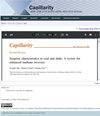非均质多孔介质中弯曲度和混合润湿性对自发吸胀影响的数值研究
Q1 Physics and Astronomy
引用次数: 19
摘要
多孔介质的自发渗吸在许多工业过程中发挥着重要作用,但由于天然多孔介质结构复杂、表面性质多样,人们对其潜在机制仍知之甚少。为了填补这一空白,采用准三维颜色梯度晶格玻尔兹曼模型模拟非均质多孔介质微模型中的自发吸胀,系统地研究了粘度比、扭曲度和混合润湿性对自发吸胀的影响。结果表明:挠度对吸胀的影响小于粘度比,当粘度比小于1时,驱替不稳定,当粘度比大于1时,驱替稳定;通过建立润湿流体饱和度与时间的幂律关系,发现尺度指数不仅受扭曲度的影响,还与微模型的孔喉结构有关。此外,混合润湿性对驱替稳定性有显著影响,特别是当两组分接触角差较大时。具体来说,两种润湿性的混合程度越大,位移越不稳定,导致界面粗化增强。因此,标度指数更偏离卢卡斯-沃什伯恩方程的预测。由于流路连通性降低,混合润湿性条件下的润湿液吸吸速率低于均匀润湿性条件下的润湿液吸吸速率,无论后者在理论上是否对应缓慢驱替。引用本文:刁中,李生,刘伟,刘辉,夏强。非均质多孔介质中弯曲度和混合润湿性对自发吸胀影响的数值研究。毛细管学,2021,4(3):50-62,doi: 10.46690/capi.2021.03.02本文章由计算机程序翻译,如有差异,请以英文原文为准。
Numerical study of the effect of tortuosity and mixed wettability on spontaneous imbibition in heterogeneous porous media
Spontaneous imbibition in porous media plays an important role in numerous industrial processes, but its underlying mechanisms are still poorly understood due to the complicated structure and multiple surface properties of natural porous media. In order to fill this gap, a quasi-three-dimensional color-gradient lattice Boltzmann model is applied to simulate the spontaneous imbibition in heterogeneous porous media micromodels, where the influence of viscosity ratio, tortuosity and mixed wettability is systematically investigated. Results show that the tortuosity has less influence on imbibition than the viscosity ratio, which leads to unstable displacement for viscosity ratios smaller than unity and to stable displacement for viscosity ratios greater than unity. By establishing the power-law relationship between wetting fluid saturation and time, it is found that the scaling exponent is not only affected by tortuosity, but also related to pore throat structure of the micromodel. In addition, the mixed wettability is found to significantly influence the stability of displacement, especially when the contact angle difference of two constituents is large. Specifically, the greater the mixing degree of two wettabilities, the more unstable the displacement will become, which results in an enhanced interface roughening. Accordingly, the scaling exponent deviates more from the prediction from the Lucas-Washburn equation. Due to the reduced connectivity of flow paths, the wetting fluid imbibition rate in mixed wettability condition is lower than that in uniform wettability condition, no matter whether the latter theoretically corresponds to a slow displacement or not. Cited as: Diao, Z., Li, S., Liu, W., Liu, H., Xia, Q. Numerical study of the effect of tortuosity and mixed wettability on spontaneous imbibition in heterogeneous porous media. Capillarity, 2021, 4(3): 50-62, doi: 10.46690/capi.2021.03.02
求助全文
通过发布文献求助,成功后即可免费获取论文全文。
去求助
来源期刊

Capillarity
Physics and Astronomy-Surfaces and Interfaces
CiteScore
7.10
自引率
0.00%
发文量
15
审稿时长
2~3 weeks
期刊介绍:
Capillarity publishes high-quality original research articles and current reviews on fundamental scientific principles and innovations of capillarity in physics, chemistry, biology, environmental science and related emerging fields. All advances in theoretical, numerical and experimental approaches to capillarity in capillary tube and interface dominated structure and system area are welcome.
The following topics are within (but not limited to) the scope of capillarity:
i) Capillary-driven phenomenon in natural/artificial tubes, porous and nanoporous materials
ii) Fundamental mechanisms of capillarity aided by theory and experiments
iii) Spontaneous imbibition, adsorption, wicking and related applications of capillarity in hydrocarbon production, chemical process and biological sciences
iv) Static and dynamic interfacial processes, surfactants, wettability, film and colloids
v) New approaches and technologies on capillarity
Capillarity is a quarterly open access journal and free to read for all. The journal provides a communicate platform for researchers who are interested in all fields of capillary phenomenon.
 求助内容:
求助内容: 应助结果提醒方式:
应助结果提醒方式:


